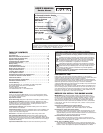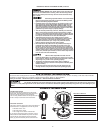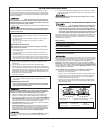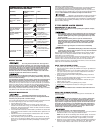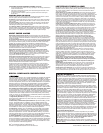
LOCATIONS TO AVOID FOR SMOKE ALARMS, Continued
•
In insect infested areas. Insects can clog openings to the sensing chamber and
cause unwanted alarms.
• Less than 12 inches (305 mm) away from fluorescent lights. Electrical “noise”
can interfer
e with the sensor.
•
In “dead air” spaces. “Dead air” spaces may prevent smoke from reaching the
Smoke Alarm.
AVOIDING DEAD AIR SPACES
“Dead air” spaces may pr
event smoke from reaching the Smoke Alarm. To avoid
dead air spaces, follow the installation r
ecommendations below.
On ceilings, install Smoke Alarms as close to the center of the ceiling as possible.
If this is not possible, install the Smoke Alarm at least 4 inches (102 mm) from the
wall or cor
ner.
For wall mounting (if allowed by building codes), the top edge of Smoke Alarms
should be placed between 4 inches (102 mm) and 12 inches (305 mm) fr
om the
wall/ceiling line, below typical “dead air” spaces.
On a peaked, gabled, or cathedral ceiling, install the first Smoke Alarm within 3
feet (0.9 meters) of the peak of the ceiling, measured horizontally. Additional Smoke
Alarms may be r
equired depending on the length, angle, etc. of the ceiling's slope.
Refer to NFP
A 72 for details on requirements for sloped or peaked ceilings.
LIMITED WARRANTY
BRK Brands, Inc., ("BRK") the maker of BRK
®
brand and First Alert
®
brand
products, warrants that for a period of ten years from the date of purchase,
this product will be free from defects in material and workmanship. BRK, at
its option, will repair or replace this product or any component of the product
found to be defective during the warranty period. Replacement will be made
with a new or remanufactured product or component. If the product is no
longer available, replacement may be made with a similar product of equal
or gr
eater value. This is your exclusive warranty
.
This warranty is valid for the original retail purchaser from the date of initial
r
etail pur
chase and is not transferable. Keep the original sales receipt. Proof
of purchase is required to obtain warranty performance. BRK dealers, service
centers, or retail stores selling BRK products do not have the right to alter,
modify or any way change the terms and conditions of this warranty.
This warranty does not cover normal wear of parts or damage resulting from
any of the following: negligent use or misuse of the product, use on improper
voltage or current, use contrary to the operating instructions, disassembly,
r
epair or alteration by anyone other than BRK or an authorized service
center
. Further
, the warranty does not cover Acts of God, such as fir
e, flood,
hurricanes and tornadoes or any batteries that are included with this unit.
BRK shall not be liable for any incidental or consequential damages caused
by the breach of any express or implied warranty. Except to the extent
pr
ohibited by applicable law, any implied warranty of merchantability or fitness
for a particular purpose is limited in duration to the duration of the above
warranty. Some states, provinces or jurisdictions do not allow the exclusion
or limitation of incidental or consequential damages or limitations on how
long an implied warranty lasts, so the above limitations or exclusion may not
apply to you. This warranty gives you specific legal rights, and you may also
have other rights that vary from state to state or province to province.
How to Obtain W
arranty Service
Service:
If service is required, do not return the product to your retailer.
In order to obtain warranty service, contact the Consumer Affairs Division at
1-800-323-9005, 7:30 AM - 5:00 PM Central Standar
d Time, Monday thr
ough
Friday. To assist us in serving you, please have the model number and date
of pur
chase available when calling.
For W
arranty Service return to:
BRK Brands, Inc., 25 Spur Drive, El Paso, TX 79906
Battery: BRK Brands, Inc. make no warranty, express or implied, written or
oral, including that of mer
chantability or fitness for any particular purpose with
respect to battery.
SPECIAL COMPLIANCE CONSIDERATIONS
This Smoke Alarm alone is not a suitable substitute for complete fire detection
systems in places housing many people—like apartment buildings, condo-
miniums, hotels, motels, dormitories, hospitals, long-term health care facilities,
nursing homes, day care facilities, or group homes of any kind—even if they
wer
e once single-family homes. It is not a suitable substitute for complete fir
e
detection systems in war
ehouses, industrial facilities, commercial buildings,
and special-purpose non-residential buildings which require special fire
detection and alarm systems. Depending on the building codes in your area,
this Smoke Alarm may be used to pr
ovide additional pr
otection in these facilities.
The following information applies to all four types of buildings listed below:
In new construction, most building codes require the use of AC or AC/DC
power
ed Smoke Alarms only
. AC, AC/DC, or DC power
ed Smoke Alarms can be
used in existing construction as specified by local building codes. Refer to NFPA
72 (National Fire Alarm Code) and NFPA 101 (Life Safety Code), local building
codes, or consult your Fir
e Department for detailed fir
e pr
otection r
equir
ements
in buildings not defined as “households.”
1. Single-Family Residence: Single family home, townhouse. It is recommended
Smoke Alarms be installed on every level of the home, in every bedroom, and in
each bedr
oom hallway
.
2. Multi-Family or Mixed Occupant Residence: Apartment building, condo-
minium. This Smoke Alarm is suitable for use in individual apartments or
condos, pr
ovided a primary fir
e detection system alr
eady exists to meet fir
e
detection requirements in common areas like lobbies, hallways, or porches.
Using this Smoke Alarm in common areas may not provide sufficient warning
to all residents or meet local fire protection ordinances/regulations.
3. Institutions: Hospitals, day car
e facilities, long-term health car
e facilities.
This Smoke Alarm is suitable for use in individual patient sleeping/resident
r
ooms, provided a primary fire detection system already exists to meet fire
detection requirements in common areas like lobbies, hallways, or porches.
Using this Smoke Alarm in common areas may not provide sufficient warning
to all r
esidents or meet local fir
e pr
otection or
dinances/regulations.
4. Hotels and Motels: Also boarding houses and dormitories. This Smoke
Alarm is suitable for use inside individual sleeping/resident rooms, provided a
primary fir
e detection system alr
eady exists to meet fir
e detection r
equir
ements
in common ar
eas like lobbies, hallways, or porches. Using this Smoke Alarm
in common areas may not provide sufficient warning to all residents or meet
local fire protection ordinances/regulations.
LIMITATIONS OF SMOKE ALARMS
Smoke Alarms have played a key r
ole in reducing deaths resulting from home fires
worldwide. However, like any warning device, Smoke Alarms can only work if they
are properly located, installed, and maintained, and if smoke reaches the Alarms.
They ar
e not foolproof.
Smoke alar
ms may not waken all individuals.
Practice the escape plan at least
twice a year, making sure that everyone is involved – from kids to grandparents.
Allow childr
en to master fire escape planning and practice before holding a fire drill
at night when they ar
e sleeping. If children or others do not readily waken to the
sound of the smoke alarm, or if there are infants or family members with mobility
limitations, make sur
e that someone is assigned to assist them in fire drill and in
the event of an emer
gency. It is recommended that you hold a fire drill while family
members are sleeping in order to determine their response to the sound of the
smoke alarm while sleeping and to determine whether they may need assistance
in the event of an emer
gency.
Smoke Alarms cannot work without power. Battery operated units cannot work
if the batteries ar
e missing, disconnected or dead, if the wrong type of batteries are
used, or if the batteries ar
e not installed correctly. AC units cannot work if the AC
power is cut off for any reason (open fuse or circuit breaker, failure along a power line
or at a power station, electrical fir
e that burns the electrical wires, etc.). If you are
concer
ned about the limitations of battery or AC power, install both types of units.
Smoke Alarms cannot detect fires if the smoke does not reach the Alarms.
Smoke fr
om fires in chimneys or walls, on roofs, or on the other side of closed doors
may not r
each the sensing chamber and set off the Alarm. That is why one unit
should be installed inside each bedroom or sleeping area—especially if bedroom or
sleeping ar
ea doors are closed at night—and in the hallway between them.
Smoke Alar
ms may not detect fire on another floor or area of the dwelling.
For example, a stand-alone unit on the second floor may not detect smoke fr
om a
basement fire until the fire spreads. This may not give you enough time to escape
safely
. That is why recommended minimum protection is at least one unit in every
sleeping ar
ea, and every bedroom on every level of your dwelling. Even with a unit on
every floor, stand-alone units may not provide as much protection as interconnected
units, especially if the fir
e starts in a remote area. Some safety experts recommend
installing inter
connected AC powered units with battery back-up (see “About Smoke
Alarms”) or professional fire detection systems, so if one unit senses smoke, all units
alarm. Inter
connected units may provide earlier warning than stand-alone units since
all units alarm when one detects smoke.
Smoke Alar
ms may not be heard.
Though the alarm hor
n in this unit meets or
exceeds current standards, it may not be heard if: 1) the unit is located outside a
closed or partially closed door
, 2) residents recently consumed alcohol or drugs,
3) the Alarm is drowned out by noise from stereo, TV, traffic, air conditioner or other
appliances, 4) residents are hearing impaired or sound sleepers.
Special purpose
units, like those with visual and audible alarms, should be installed for hearing
impaired r
esidents.
Smoke Alarms may not have time to alar
m before the fire itself causes
damage, injur
y, or death, since smoke from some fires may not reach the
unit immediately. Examples of this include persons smoking in bed, children
playing with matches, or fires caused by violent explosions resulting from
escaping gas.
Smoke Alarms are not foolproof. Like any electronic device, Smoke Alarms are
made of components that can wear out or fail at any time. You must test the unit
weekly to ensure your continued protection. Smoke Alarms cannot prevent or
extinguish fires. They are not a substitute for property or life insurance.
Smoke Alarms have a limited life. The unit should be replaced immediately if it is
not operating properly. You should always replace a Smoke Alarm after 10 years from
date of purchase. Write the purchase date on the space provid
ed on back of unit.
ABOUT SMOKE ALARMS
Battery (DC) operated Smoke Alarms: Provide protection even when electricity
fails, pr
ovided the batteries are fresh and correctly installed. Units are easy to install,
and do not r
equire professional installation. However, they do not provide intercon-
nected functionality.
AC powered Smoke Alarms: Can be interconnected so if one unit senses smoke,
all units alarm. They do not operate if electricity fails. AC with batter
y (DC) back-
up:
will operate if electricity fails, pr
ovided the batteries are fresh and correctly
installed. AC and AC/DC units must be installed by a qualified electrician.
W
ireless Interconnected Alarms:
Of
fer the same interconnected functionality as
with har
dwired alarms, without wires. Units are easy to install and do not require
professional installation. They provide protection even when electricity fails,
pr
ovided the batteries are fresh and correctly installed.
Smoke Alar
ms for Solar or Wind Energy users and battery backup power
systems: AC power
ed Smoke Alarms should only be operated with true or pure
sine wave inverters. Operating this Smoke Alarm with most battery-powered UPS
(uninterruptible power supply) products or square wave or “quasi sine wave”
inverters
will damage the Alar
m
. If you ar
e not sure about your inverter or UPS
type, please consult with the manufacturer to verify.
Smoke Alarms for the hearing impaired: Special purpose Smoke Alarms should
be installed for the hearing impaired. They include a visual alarm and an audible
alarm horn, and meet the requirements of the Americans With Disabilities Act.
These units can be interconnected so if one unit senses smoke, all units alarm.
Smoke alarms are not to be used with detector guards unless the combination
has been evaluated and found suitable for that purpose.
All these Smoke Alarms are designed to provide early warning of fires if located,
installed and cared for as described in the user’s manual, and if smoke reaches the
Alarm. If you are unsure which type of unit to install, refer to NFPA (National Fire
Protection Association) 72 (National Fire Alarm Code) and NFPA 101 (Life Safety Code).
National Fire Protection Association, One Batterymarch Park, Quincy, MA 02269-9101.
Local building codes may also require specific units in new construction or in
different areas of the home.
Printed in Mexico M08-0134-003 K1 04/07
BRK
®
is a registered trademark of BRK Brands, Inc.
First Alert
®
is a r
egister
ed trademark of the First Alert T
rust.
7



